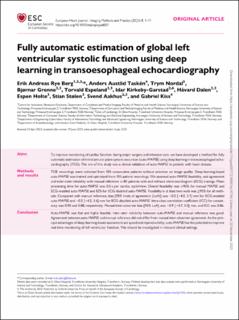| dc.contributor.author | Berg, Erik Andreas Rye | |
| dc.contributor.author | Tasken, Anders Austlid | |
| dc.contributor.author | Nordal, Trym | |
| dc.contributor.author | Grenne, Bjørnar Leangen | |
| dc.contributor.author | Espeland, Torvald | |
| dc.contributor.author | Garstad, Idar Kirkeby | |
| dc.contributor.author | Dalen, Håvard | |
| dc.contributor.author | Holte, Espen | |
| dc.contributor.author | Stølen, Stian Bergseng | |
| dc.contributor.author | Aakhus, Svend | |
| dc.contributor.author | Kiss, Gabriel Hanssen | |
| dc.date.accessioned | 2023-11-23T09:31:45Z | |
| dc.date.available | 2023-11-23T09:31:45Z | |
| dc.date.created | 2023-11-20T17:03:38Z | |
| dc.date.issued | 2023 | |
| dc.identifier.issn | 2755-9637 | |
| dc.identifier.uri | https://hdl.handle.net/11250/3104261 | |
| dc.description.abstract | Aims To improve monitoring of cardiac function during major surgery and intensive care, we have developed a method for fully automatic estimation of mitral annular plane systolic excursion (auto-MAPSE) using deep learning in transoesophageal echocardiography (TOE). The aim of this study was a clinical validation of auto-MAPSE in patients with heart disease. Methods and results TOE recordings were collected from 185 consecutive patients without selection on image quality. Deep-learning-based auto-MAPSE was trained and optimized from 105 patient recordings. We assessed auto-MAPSE feasibility, and agreement and inter-rater reliability with manual reference in 80 patients with and without electrocardiogram (ECG) tracings. Mean processing time for auto-MAPSE was 0.3 s per cardiac cycle/view. Overall feasibility was >90% for manual MAPSE and ECG-enabled auto-MAPSE and 82% for ECG-disabled auto-MAPSE. Feasibility in at least two walls was ≥95% for all methods. Compared with manual reference, bias [95% limits of agreement (LoA)] was −0.5 [−4.0, 3.1] mm for ECG-enabled auto-MAPSE and −0.2 [−4.2, 3.6] mm for ECG-disabled auto-MAPSE. Intra-class correlation coefficient (ICC) for consistency was 0.90 and 0.88, respectively. Manual inter-observer bias [95% LoA] was −0.9 [−4.7, 3.0] mm, and ICC was 0.86. Conclusion Auto-MAPSE was fast and highly feasible. Inter-rater reliability between auto-MAPSE and manual reference was good. Agreement between auto-MAPSE and manual reference did not differ from manual inter-observer agreement. As the principal advantages of deep-learning-based assessment are speed and reproducibility, auto-MAPSE has the potential to improve real-time monitoring of left ventricular function. This should be investigated in relevant clinical settings. | en_US |
| dc.language.iso | eng | en_US |
| dc.publisher | Oxford University Press | en_US |
| dc.relation.uri | https://doi.org/10.1093/ehjimp/qyad007 | |
| dc.rights | Navngivelse 4.0 Internasjonal | * |
| dc.rights.uri | http://creativecommons.org/licenses/by/4.0/deed.no | * |
| dc.title | Fully automatic estimation of global left ventricular systolic function using deep learning in transesophageal echocardiography | en_US |
| dc.title.alternative | Fully automatic estimation of global left ventricular systolic function using deep learning in transesophageal echocardiography | en_US |
| dc.type | Journal article | en_US |
| dc.description.version | publishedVersion | en_US |
| dc.source.volume | 1 | en_US |
| dc.source.journal | European Heart Journal - Imaging Methods and Practice | en_US |
| dc.source.issue | 1 | en_US |
| dc.identifier.doi | https://doi.org/10.1093/ehjimp/qyad007 | |
| dc.identifier.cristin | 2199081 | |
| dc.relation.project | Norges forskningsråd: 237887 | en_US |
| cristin.ispublished | true | |
| cristin.fulltext | original | |

